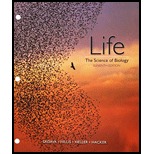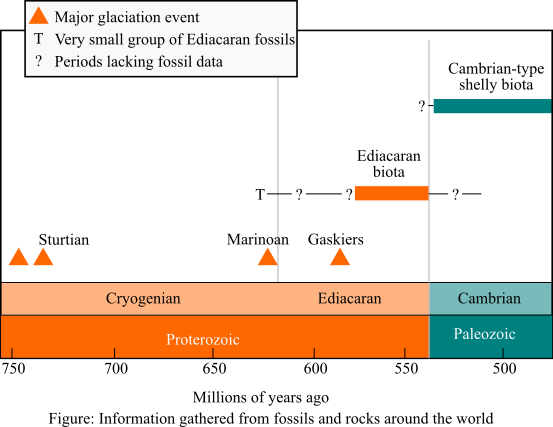
Concept explainers
To review:
The difference between the geological strata, in which Ediacaran fossils and Cambrian-type shelly biota fossils were discovered.
Given:
The diagram given below shows the evidence of fossils and rocks from places all over the world:

Introduction:
A stratum is a layer formed of sedimentary rocks or igneous rock. The earth’s surface generally consists of one kind of matter having a continuous deposition. The Ediacaran period lasted from about 635 to 542 million years ago (mya) and the Cambrian period lasted from 541 to 485 mya.
Explanation of Solution
The difference between the Cambrian strata and the Ediacaran strata are given in the table below:
Table: Difference between Cambrian and Ediacaran strata
| Cambrian strata | Ediacaran strata |
| The Cambrian period is the period of ancient life that lasted about 500 mya and it is known for dramatic evolutionary changes in the life on earth. | The Ediacaran period lasted from about 550 to 600 mya and is mostly characterized by soft-bodied and sessile animals. |
| Cambrian strata did not witness any glaciation event. | Ediacaran strata faced a major glaciation event. |
| The Cambrian strata show a wide variety and number of fossil records. | Ediacaran strata have a very sparse fossil record because the soft-bodied animals could not be fossilized. |
Thus, it can be concluded that the Ediacaran strata do not have a well-established fossil record because its biota consisted mainly of soft-bodied animals and they faced a major glaciation event.
Want to see more full solutions like this?
- please fill in missing parts , thank youarrow_forwardplease draw in the answers, thank youarrow_forwarda. On this first grid, assume that the DNA and RNA templates are read left to right. DNA DNA mRNA codon tRNA anticodon polypeptide _strand strand C с A T G A U G C A TRP b. Now do this AGAIN assuming that the DNA and RNA templates are read right to left. DNA DNA strand strand C mRNA codon tRNA anticodon polypeptide 0 A T G A U G с A TRParrow_forward
- Please identify the curve shown below. What does this curve represent? Please identify A, B, C, D, and E (the orange oval). What is occurring in these regions?arrow_forwardPlease identify the test shown here. 1) What is the test? 2) What does the test indicate? How is it performed? What is CX? 3) Why might the test be performed in a clinical setting? GEN CZ CX CPZ PTZ CACarrow_forwardDetermine how much ATP would a cell produce when using fermentation of a 50 mM glucose solution?arrow_forward
- Determine how much ATP would a cell produce when using aerobic respiration of a 7 mM glucose solution?arrow_forwardDetermine how much ATP would a cell produce when using aerobic respiration to degrade one small protein molecule into 12 molecules of malic acid, how many ATP would that cell make? Malic acid is an intermediate in the Krebs cycle. Assume there is no other carbon source and no acetyl-CoA.arrow_forwardIdentify each of the major endocrine glandsarrow_forward
 Biology Today and Tomorrow without Physiology (Mi...BiologyISBN:9781305117396Author:Cecie Starr, Christine Evers, Lisa StarrPublisher:Cengage Learning
Biology Today and Tomorrow without Physiology (Mi...BiologyISBN:9781305117396Author:Cecie Starr, Christine Evers, Lisa StarrPublisher:Cengage Learning
 Biology (MindTap Course List)BiologyISBN:9781337392938Author:Eldra Solomon, Charles Martin, Diana W. Martin, Linda R. BergPublisher:Cengage Learning
Biology (MindTap Course List)BiologyISBN:9781337392938Author:Eldra Solomon, Charles Martin, Diana W. Martin, Linda R. BergPublisher:Cengage Learning Biology: The Dynamic Science (MindTap Course List)BiologyISBN:9781305389892Author:Peter J. Russell, Paul E. Hertz, Beverly McMillanPublisher:Cengage Learning
Biology: The Dynamic Science (MindTap Course List)BiologyISBN:9781305389892Author:Peter J. Russell, Paul E. Hertz, Beverly McMillanPublisher:Cengage Learning Concepts of BiologyBiologyISBN:9781938168116Author:Samantha Fowler, Rebecca Roush, James WisePublisher:OpenStax College
Concepts of BiologyBiologyISBN:9781938168116Author:Samantha Fowler, Rebecca Roush, James WisePublisher:OpenStax College Human Biology (MindTap Course List)BiologyISBN:9781305112100Author:Cecie Starr, Beverly McMillanPublisher:Cengage Learning
Human Biology (MindTap Course List)BiologyISBN:9781305112100Author:Cecie Starr, Beverly McMillanPublisher:Cengage Learning





